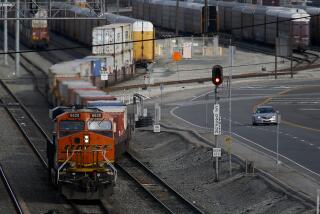Improving State’s Air Quality
While we appreciate The Times’ acknowledgment of California’s air pollution problems, we think Robert Jones’ Nov. 22 Essay casts an unfair light on the efforts the state has made to solve them. Since the Air Resources Board was established in 1968, California traditionally has had the nation’s most advanced and comprehensive air pollution control program. It has led in the development of pollution control equipment that is now commonplace on motor vehicles and industrial pollution sources.
Ideas such as catalytic converters, unleaded gasoline and sophisticated hardware to reduce pollution from refineries and power plants were pioneered in California. The zero emission vehicle and cleaner-running diesels are other examples of this state’s determination to protect its citizens from the effects of poor air quality. Electric vehicles are one strategy for not only cleaning the state’s air but for developing a high-technology industry that will help replace the thousands of jobs lost to base closures and aerospace industry downsizing. Their introduction next year will further spur the development of long-range, extended-life batteries that auto makers say consumers want.
During the past 10 years California has cut ozone-forming pollution from diesels by 60% while particulate emissions have been slashed by 90%. The agreement mentioned by Jones guarantees that Californians will not be exposed to the high levels of ozone-forming nitrogen oxides and particulates that threaten our health and cost our industries. It also assures us that trucks crossing our borders will be as clean-running as those that are registered in California.
JOHN D. DUNLAP III
Chairman, Air Resources Board
Sacramento
*
* Jones makes an excellent point about the need for cleaner trucks and buses. However, he fails to recognize that electric vehicles are just as integral to achieving clean air. Why? Because we will continue to need cars and trucks long into the next century.
Motor vehicles are the single largest source of air pollution in Southern California and need further control. Even when trucks meet the cleaner 2004 standard, they will still be a sizable source of pollution. Likewise, even as gasoline cars meet the state’s low-emission vehicle standards, they will remain a large source of pollution.
So cleaner technologies for trucks, buses and cars are needed if the next generation is to grow up breathing healthful air. These technologies will shift trucks and buses from diesel to natural gas and other clean fuels and cars and buses from internal combustion engines to electric motors powered by batteries and eventually to fuel cells powered by hydrogen.
JAMES M. LENTS
Executive Officer
South Coast Air Quality Management
District, Diamond Bar
More to Read
Get the L.A. Times Politics newsletter
Deeply reported insights into legislation, politics and policy from Sacramento, Washington and beyond. In your inbox three times per week.
You may occasionally receive promotional content from the Los Angeles Times.










